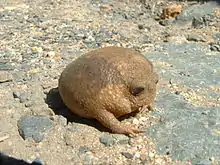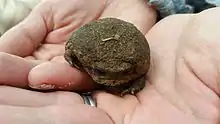Cape rain frog
The cape rain frog or giant rain frog (Breviceps gibbosus) is a species of frog in the family Brevicipitidae.[2] Adults grow up to 45 mm in length. It was the first African frog species to be scientifically described by Carl Linnaeus in 1758, under the name Rana gibbosa. It is the most common and largest of rain frogs.[3]
| Cape rain frog | |
|---|---|
 | |
| Scientific classification | |
| Kingdom: | Animalia |
| Phylum: | Chordata |
| Class: | Amphibia |
| Order: | Anura |
| Family: | Brevicipitidae |
| Genus: | Breviceps |
| Species: | B. gibbosus |
| Binomial name | |
| Breviceps gibbosus | |
Distribution and habitat

The species is endemic to South Africa, where it occurs in the far southwestern Cape, in Cape Town and northwards as far as Citrusdal. In this area it inhabits Mediterranean-type shrubby vegetation, known as fynbos, renosterveld, pastureland on farms, rural gardens, and even urban areas. It seems to adapt well to suburban gardens, but like most frog species it is vulnerable to herbicide poisons and domestic pets.[4]
Ecology
The Cape rain frog lives underground and usually emerges just before rains (whence it got its common name). It may also be seen in misty or damp conditions. Its burrowing provides a role in aerating soil in the southwestern Cape. It feeds on worms and small insects. When alarmed, it increases its apparent size by swallowing air; hence the species is given the Afrikaans common name of blaasoppie. As burrowing frogs, they have thick, muscular legs, which enable them to burrow for shelter. This species does not require open water to breed; in fact, it cannot swim and will drown if placed in water.[3]
Breeding
During mating season, males call from beneath vegetation or from their burrows so that the females can locate them. Since he is too small to get a firm grip on the female, she secretes a sticky liquid that glues him to her back. Fertilisation takes place in a burrow that the female has dug where groups of approximately 22 eggs are laid. They lay fertile eggs and jelly capsules, which provide moisture for the developing froglets. The females will remain burrowed near the eggs until they become young froglets without undergoing the tadpole stage.[3]
Conservation
Then species is currently classified as near threatened by the IUCN. The main threats consist of ongoing habitat loss in the diminishing fynbos biomes, through the expansion of urban sprawl and agriculture.[4]
References
- IUCN SSC Amphibian Specialist Group; South African Frog Re-assessment Group (SA-FRoG) (2017). "Breviceps gibbosus". IUCN Red List of Threatened Species. 2017: e.T3069A77162627. doi:10.2305/IUCN.UK.2017-2.RLTS.T3069A77162627.en.
- Frost, Darrel R. (2013). "Names described as 'Breviceps gibbosus'". Amphibian Species of the World: an Online Reference. Version 5.6 (9 January 2013). Retrieved 30 November 2013.
- "Cape rain frog". SANBI. Archived from the original on 2016-08-23. Retrieved 2016-09-13.
- South African Frog Re-assessment Group (SA-FRoG), IUCN SSC Amphibian Specialist Group, 2010. Breviceps gibbosus. In: IUCN 2012. IUCN Red List of Threatened Species. Version 2012.2.
| Wikimedia Commons has media related to Breviceps gibbosus. |
